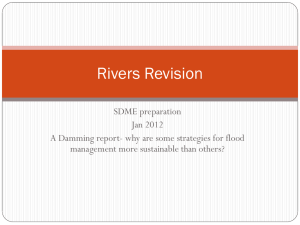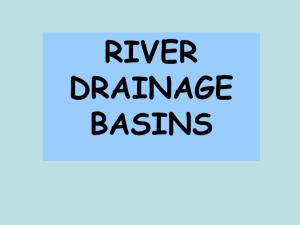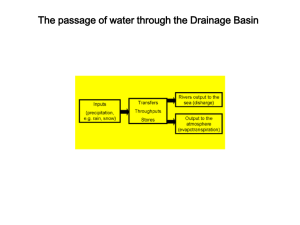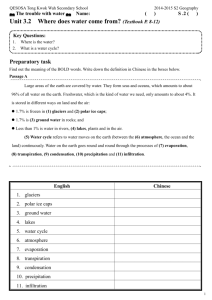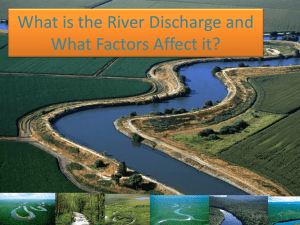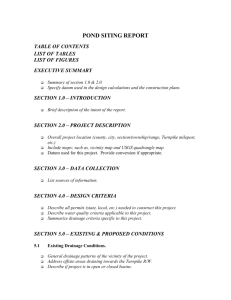Storm Hydrographs revision booklet
advertisement
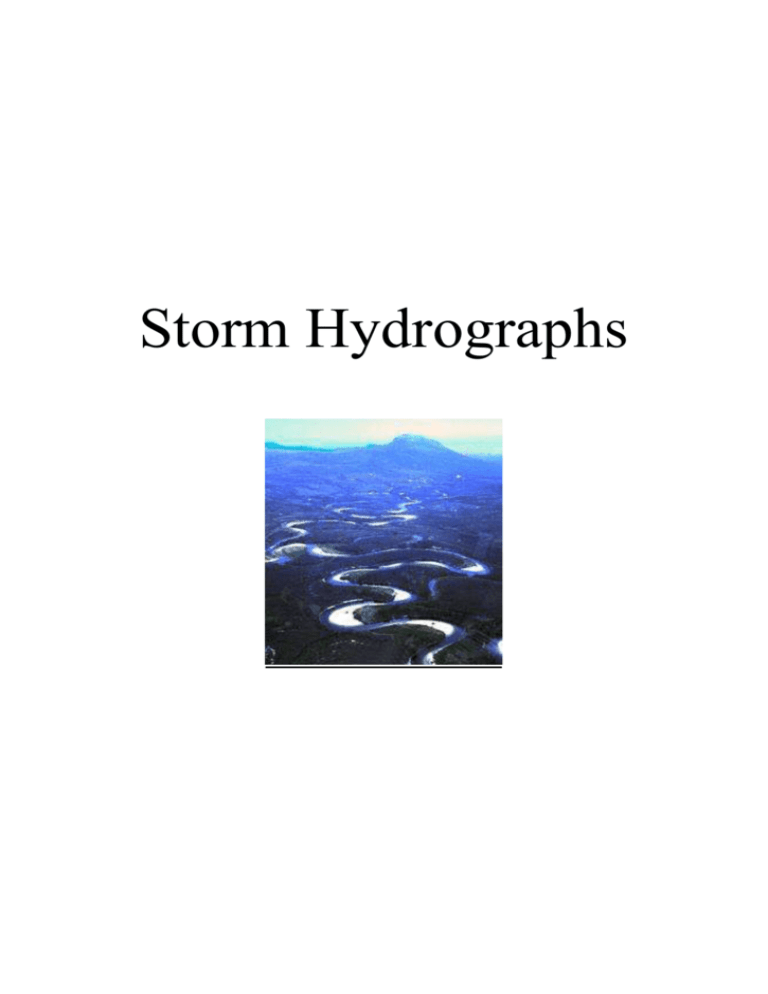
Storm Hydrographs What is the flood hydrograph ? The flood hydrograph is a means of showing the discharge of a river at a given point (gauging station) over a short period of time. Discharge is therefore the water not stored in the drainage basin by interception, as surface storage, groundwater storage or lost through evapotranspiration. Following an increase in rainfall, there will also be an increase in the level and discharge of the river. The diagram is really showing you how the river responds to an individual storm. Note: A gauging station is one specific point on a river's course. At this station a number of readings will be taken such as rainfall, velocity, discharge etc. These readings are then converted into a hydrograph such as the one seen above. They help to predict a river's response to storms and thus are essential in planning flood prevention. A country's state of development will dictate how many gauging station's it can afford to have on its rivers. For example the Mississippi (a constant flood risk), in the USA has over 72,000 stations along its course and tributaries. (1) Approach segment This part of the graph shows the discharge of a river before a storm. Discharge is measured in a unit called cumecs (m3/sec). When the storm begins, the river’s response is very slow, even negligable for although some rain falls directly into the channel, most falls elsewhere in the drainage basin and takes time to reach the channel. 2) Rising Limb When the initial surface runoff and later, the throughflow eventually reach the river there is a rapid increase in discharge as indicated by the rising limb. The steeper the rising limb, the faster the response to rainfall i.e. water reaches the channel more quickly. 3) Peak Discharge This occurs when the river reaches its highest level. 4) Lag Time This is the period of time between maximum precipitation and peak discharge. The lag time varies according to the conditions within the drainage basin for e.g. Soil and rock type Slope gradient and size of the basin Drainage density Type and amount of vegetation Water already in storage in the drainage basin Rivers with a short lag time tend to experience a higher peak discharge and flooding is more likely to happen. A longer lag time reduces the risk of flooding. 5) Falling or receding limb This is the part of the graph where discharge is decreasing and river levels are falling. This segment is usually less steep than the rising limb because throughflow is being released relatively slowly into the channel. By the time all the water from the storm has passed through the channel at a given location, the river will have returned to baseflow level - unless another storm has started in the basin. 6) Stormflow Is the discharge, both surface and subsurface flow attributed to a single storm. 7) Baseflow The flow of water in a river which is produced by sub surface processes, especially groundwater flow. Baseflow is very slow to respond to the storm, but by continually releasing groundwater it maintains the river’s flow during periods of low precipitation. Indeed, it is more significant over a longer period of time than an individual storm. It also reflects seasonal changes in: Precipitation Snowmelt Vegetation Evapotranspiration 8) Bankfull Discharge Occurs when a river’s water level reaches the top of the channel. Any further increase results in flooding The effect of agriculture on the hydrograph Farming activity may speed up or slow down the delivery of surface and sub surface water to the river. For instance many soil conservation measures are designed to reduce runoff and soil erosion which accompany overland flow. Popular strategies are hill slope terracing ( see image below) or planting of permanent grassland on vulnerable soils. These techniques will reduce the quick flow of water. In contrast, the purpose of land drainage is to accelerate the transfer of water to the river channel. In general, the more intensive the farming, the greater the modification of the natural process of water flow through the drainage basin. Figure 1: Rice terraces in Bali, Indonesia We will discuss two major faming practices and their effects on the water flow. 1) Intensive farming Intensive farming practices change the way that water is stored and its movement through the soil horizons. Firstly, changes in vegetation cover will effect interception, surface runoff, infiltration and percolation. Secondly: i) Ploughing will turn over soil and increase infiltration of water due to an increase in air spaces. ii) The application of fertiliser will encourage eutrophication in waterways, slowing discharge rate iii) The impact of equipment and animals will compact soil encouraging surface runoff. - all these factors will all alter the soil texture and so the storage and infiltration capacity of the soil. The timing of activities is also important. For example in the former USSR, ploughing fields in the autumn rather than the spring reduced runoff in the forest zone by 1.5 - 2 times. 2) Land drainage The primary aim of most land drainage schemes is to lower the water table and so prevent water logging. This is done by a combination of cutting deeper ditches and laying pipes beneath the field surfaces. The improved drainage permits the intensification of farming practices, e.g. a change from grazing to arable cropping. The Institute of Hydrology in the UK has carried out research into the impacts of field drainage and stream channel improvement, and made these conclusions: 1) The drainage of heavy clay soils, which when undrained are prone to prolonged surface saturation, generally results in a lowering of large and medium peaks on the storm hydrograph of neighbouring streams. 2) On more permeable soils, which are less prone to surface saturation, the usual effect of drainage is to improve the speed of subsurface discharges. This tends to increase hydrograph peak flows in nearby streams. 3) At the drainage basin scale, artificial drainage ditches produce a significant shortening of hydrograph lag times. Case Study : Withernwick, Holderness, England (The field drainage scheme)\ Withernwick lies on the flat, intensively farmed Holderness plains. The local soils consist of clay loams increasing in density and massive structure with depth.. Between 1974 and 1975, hydrologists studied 4 fields on Westland Farm before and after a field drainage scheme was completed on 81% of the area. The hydrograph below shows a comparison of before and after the field drainage scheme occurred at one hour intervals. Delivery of rainwater to the drainage ditches was accelerated by the field drainage network. The effect of urbanisation on the storm hydrograph Case Study: The Canon’s Brook basin, Harlow (Essex) (Taken from Bishop & Prosser,1995) Building for Harlow New Town began in late 1951 and resulted in the land use changes shown in Figure 3.49 above. By 1968, 16.6 per cent of the drainage basin was covered by impermeable surfaces which drained into sewers directly to the Canon’s Brook. Impermeable surfaces included roads, houses and car parks, the presence of which all increase the rate of runoff and overland flow. The changes in the flows of the Brook are shown in the diagram above.You only need to look at modal flow which has increased over the years. The rainfall inputs have shown no significant changes and so any changes in stream flow can largely be attributed to the impacts of urbanisation. A 15 per cent stone paving of the drainage basin increased runoff by 59.4mm, i.e. an increase of about 30 per cent above a rural drainage basin runoff. Effect of vegetation type and cover on the hydrograph Case Study: The River Severn and the River Wye The Plynlimon research catchments showing the Rivers Severn and Wye and their tributaries (Adapted from Collins, 1995) The map above contrasts the different vegetation types of the River Severn and River Wye. We know that the geology and annual precipitation for both basins are similar so another factor is responsible for the different shapes of their hydrographs below. (Adapted from Waugh, 1995) As the land use map above shows, the River Wye flows over moors and grassland, whereas the River Severn flows through an area of coniferous forest. Interception in the River Severn basin by vegetation will therefore be higher, reducing the amount and intensity of rapid surface runoff. This will give the hydrograph for the River Severn a longer lag time and a delayed, less high peak flow. The effect of geology, structure and soils on the hydrograph Case Study The River Kennet and River Loddon (Thames Basin) Background information We know already that a proportion of precipitation input passes through the soil store, to percolate more deeply into the groundwater store. It is the groundwater store which regulates the slow flow supply and base flow of streams. The behaviour of this store is influenced by: Rock type (geology), Geological structure (faulting, tilting of rock formations) Soil type. Rocks vary in their porosity (see table below) and permeability, and so in their ability to hold and transfer water. For instance crystalline rocks such as granite have low porosity and permeability. However even rocks of low porosity may transmit water efficiently if they are well jointed for example Carboniferous Limestone. Limestone is well jointed and has bedding planes which give it permeability. AVERAGE POROSITY RANGE (%) Soils 55 50-65 Clay 50.5 42-59 Silt 43.5 37-50 Sand 35 30-40 Gravel 34 29-39 Sand and Gravel 27 20-34 Sandstone 18 8-28 Limestone 20 5-35 Shale 8 2-14 Crystalline rock 5 1-10 MATERIAL Rivers Kennet and Loddon Hydrographs, 1986 The hydrographs below are for two drainage basins within the Thames drainage basin. Both are for the same year, and both experience similar weather conditions. Note that the Kennet drainage basin is larger than the Loddon basin. The key difference is their geology: the Kennet basin is largely permeable with limestone and gravel rock type, while the River Loddon is underlain mostly by impermeable rocks (shale and granite). How shape and size of river basins affect the hydrograph 1) Size of basin If a basin is small it is likely that rainfall will reach the main channel more rapidly than within a larger basin where the water has much further to travel. Lag time will therefore be shorter the smaller the basin 2) Shape of basin It has long been accepted that a circular basin is more likely to have a shorter lag time and a higher peak flow than an elongated basin (see diagram below). All the points on the watershed of the former are approximately equal in distance from the gauging station., whereas in the latter it takes longer for water from the edges of the basin to reach the gauging station. This however is not true in flood conditions. When a river is in flood, slope angle and size of basin are far more reliable indicators. The effect of relief on the hydrograph Steep slopes A drainage basin with steep slopes such as shown in the diagram below, is likely to show: 1) More quickflow 2) A shorter lag time 3) Higher peak discharge on the hydrograph. The pattern above is because steeper slopes encourage more overland flow, faster runoff and faster throughflow processes which produce rapid water collection at the slope base and saturated conditions. Basins with strong relief are also likely to give relatively steep stream long profiles ( see diagrams). We must remember, however, that steep channel gradients do not always mean higher flow velocities. Gentle slopes A drainage basin which has gentle slopes and low relief, shows quite a contrasting pattern. Profile and hydrograph for gentle slopes Test your understanding 1. How will the presence of a sewerage system affect the length of lag time for the Canon’s Brook storm hydrograph ? Explain your answer. (5 marks) 2. The diagram of Canon's Brook shows the relationship between surface runoff and rainfall in a catchment before and after urbanisation. (This compares rural (before urbanisation) and urban landuse in Canon’s Brook) a) b) Describe how has urbanisation affected the amount of runoff in the catchment? (3 marks) Explain how this has happened? (4 marks) River Severn and Wye questions 1. If it were proposed to harvest the forests of the River Severn, what effect would deforestation have on the shape of the hydrograph? (4 marks) 2. Describe and account for the differences in the shapes of your hydrographs. (8 marks)
